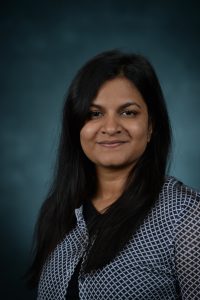
Amrita Mishra
OXFORD, Miss. – Discovering, developing and commercializing alloys and other advanced materials can take up to 20 years, but a University of Mississippi mechanical engineering professor hopes to speed up the process by applying computational methods to the periodic table.
A paper detailing that work co-authored by Amrita Mishra, a UM assistant professor, and seven other professors from other universities was published recently in Scientific Reports, a publication of Nature.
Alloys are materials made up of a blend of elements, Mishra said. Finding the right mixture of elements from the periodic table, which often happens in the lab by accident, is almost like cooking a new recipe in some ways, she said.
“The best way I describe this to my students is that if I asked them to make hot chocolate, everyone’s hot chocolate would taste different because of the amount and type of sugar, cocoa powder and milk they might add, just like similar elements in the periodic table,” Mishra said. “What we are trying to do is give engineers and scientists a recipe for which elements we would add for materials to function properly for a particular application.”
Her research is in alignment with the Materials Genome Initiative launched by the White House in 2011.
The idea behind Mishra’s work is that discovery of new materials can be accelerated by establishing design rules based on thermodynamics and electronic structure calculations.
Her hypothesis is that combining and utilizing computational methods with more traditional experiments will provide a methodology for creating composition-structure and structure-property correlations, thereby accelerating the pace of discovery of new materials and alloys.
The research is mostly done through theoretical and computational methods.
“We spend so much time on experimentation and trial-and-error methods, but we want to move away from that,” Mishra said. “We can do this by developing and using methods, which involve studying the thermodynamics and atomic arrangement of materials. Atomic interactions can predict how a material is going to perform for various applications.”
One of her research areas is focused on finding new alloy materials for turbine blades used in jet engines in hopes of finding a replacement for nickel-based super alloys, which have been around for more than 60 years. There has been some recent interest in cobalt super alloys as a potential replacement.
Mishra is trying to secure federal funding for her research.
“Advanced materials are the key for the next generation of research in clean energy, human welfare and national security,” she said. “Accelerating the pace of discovery and the deployment of modern materials is crucial in achieving global competitiveness in this day and age.”
The potential for Mishra’s research is exciting, given the difficulties materials science and engineers face when determining the proper mixture to obtain the correct property, said Josh Gladden, UM interim vice chancellor of research and sponsored programs. The number of possible combinations is so large, it’s not realistic to investigate all of them, he said.
“Prediction tools and methodologies such as the one Dr. Mishra is developing will help overcome a significant barrier in designing better materials, which will lead to wide-ranging benefits to society,” Gladden said. “The University of Mississippi is proud and excited to have her on our faculty and looks forward to many more exciting developments from her group.”